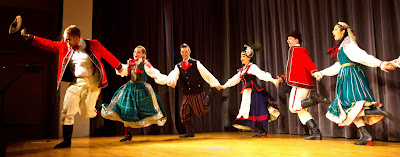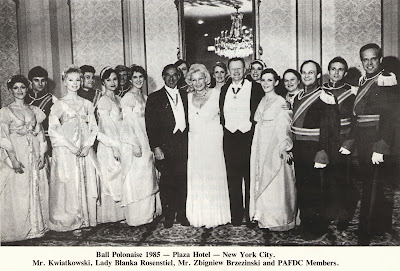as printed in the October 2013 print edition of The Polish American Journal
The Polish American Folk Dance Company of Brooklyn, New York (PAFDC) will celebrate the
75th anniversary of its founding with a 2-hour performance at New York University’s Skirball Center on Saturday, November 23 at 7:00 pm.
As part of
the celebration, the troupe will premiere three new dance suites choreographed
by Zofia Czechlewska, a former soloist with Poland’s Śląsk Song and Dance Ensemble: Kołomajki from the Beskid
Śląsk region, Mazurka featuring
maiden games at the Court balls, and Szamotuły from the
western Wielkopolska region. Resident Choreographer
Tomasz Orzechowski will debut a fusion of dances from the distinctly different White
and Green Forests of the northeastern Kurpie region, and a Cinderella-themed Mazur
Kopciuszek.
Tickets
are available at: 212-352-3101 or 866-811-4111, www.nyuskirball.org; Polish National
Home - 718-387-0505, or Forum Travel - 718-389-1010.
History
Founded
in 1938 to preserve and perpetuate Polish folk dances and songs among Americans
of Polish descent, The Polish American
Folk Dance Company was organized by Frances Wesołowska-
Popławska in New York City under the auspices of the Polish Workmen’s Aid Fund. With the assistance of other community organizations, such as the Kościuszko Foundation and the Polish-American Aid Fund, Popławska built a folk dance group that combined the traditional with the grace of classical ballet. For 30 years she taught not only those in her own troupe, but held courses for dance teachers across the country.
Popławska in New York City under the auspices of the Polish Workmen’s Aid Fund. With the assistance of other community organizations, such as the Kościuszko Foundation and the Polish-American Aid Fund, Popławska built a folk dance group that combined the traditional with the grace of classical ballet. For 30 years she taught not only those in her own troupe, but held courses for dance teachers across the country.
In
1969, Popławska relegated the direction to her most promising dancers, Stanley
Pelc and Ursula Bestecka, and soon after the group moved from Manhattan to
Greenpoint, Brooklyn. This would begin a
period of growth and transformation. With
extensive research, Pelc and Bestecka crafted a company of theatrical scale.
 Pelc
studied Polish Dance in Warsaw, and as the general manager of the company he
arranged the performance season. Bestecka
guided the expansion of the company’s costume wardrobe. Musically, the company was enriched by Halina
Kalitka, who for over 20 years served as accompanist beginning in 1970.
Pelc
studied Polish Dance in Warsaw, and as the general manager of the company he
arranged the performance season. Bestecka
guided the expansion of the company’s costume wardrobe. Musically, the company was enriched by Halina
Kalitka, who for over 20 years served as accompanist beginning in 1970. During
this period the company premiered its first full-length concert, debuted at
Lincoln Center, had tour engagements, and in 1972 participated in the World Festival of Polonian Folk Ensembles in
Rzeszów, Poland for the first time. In
total, PAFDC has participated in ten
World Festivals in Poland. Bestecka
moved to Japan in 1975 and Maria Zdzienicka Koncewicz and Jay Poko were named
assistant choreographers.
During
this period the company premiered its first full-length concert, debuted at
Lincoln Center, had tour engagements, and in 1972 participated in the World Festival of Polonian Folk Ensembles in
Rzeszów, Poland for the first time. In
total, PAFDC has participated in ten
World Festivals in Poland. Bestecka
moved to Japan in 1975 and Maria Zdzienicka Koncewicz and Jay Poko were named
assistant choreographers.  Known
to those close to him as “Skippy,” Stanley Pelc developed and shaped a company
of style, flair and prestige. Under his
watchful and meticulous eye, PAFDC
developed a vast repertoire modeled after the presentation ideal of Mazowsze. Being in close proximity to Broadway, PAFDC strived to appeal and be relevant
to both a New York theater-going audience and a Polonia audience who held
Poland’s national companies in high esteem as the pinnacle of Polish dance.
Known
to those close to him as “Skippy,” Stanley Pelc developed and shaped a company
of style, flair and prestige. Under his
watchful and meticulous eye, PAFDC
developed a vast repertoire modeled after the presentation ideal of Mazowsze. Being in close proximity to Broadway, PAFDC strived to appeal and be relevant
to both a New York theater-going audience and a Polonia audience who held
Poland’s national companies in high esteem as the pinnacle of Polish dance.
Pelc
developed a costume wardrobe fitting for the stage with color, fabric flow, design
and brilliance. The stage “look” was
uniquely their own with intricate period adornments in Polonez and Mazur, and
signature looped braids for their Krakowiak
finale. Many costumes were made in
Poland, while others were created and sewn by Mrs. Cecylia Pelc, assisted by
other mothers, as well as by the dancers themselves.
Upon
Pelc’s retirement in 1996, Daniel Dziadura – a graduate of the Studium Folklorystyczne at the
University of Marie Curie-Skłodowska, succeeded him as Artistic Director. As musical accompaniment, a Kapela Ludowa (folk band) was formed under Andrzej Buczek. A children's group – PAFDC Kids, was established under the direction of long-time member Alice Karpinski-Bajno and former Mazowsze member Katarzyna Nitecka in the Fall of 2003.
University of Marie Curie-Skłodowska, succeeded him as Artistic Director. As musical accompaniment, a Kapela Ludowa (folk band) was formed under Andrzej Buczek. A children's group – PAFDC Kids, was established under the direction of long-time member Alice Karpinski-Bajno and former Mazowsze member Katarzyna Nitecka in the Fall of 2003.
When
Dziadura retired in 2005, PAFDC
reorganized its leadership by creating two separate positions of Artistic
Director and Executive Director. Ryszard
Sudol was named Artistic Director and initiated a “Beginners” training program. Today PAFDC
is led by Executive Director Mariusz Bernatowicz, and Artistic Director Tomasz
Orzechowski - who completed a qualification instructor’s course in Warsaw, and performed
with folk dance groups in łomża
and at Warsaw University. The children’s
group is currently led by Diana Chrościelewski.
The
company’s repertoire consists of multiple arrangements of Poland’s national
dances, over 25 regional suites, along with staged presentations of seasonal
customs (obrzędy). The company owns over 600 costumes.
For
many years, the PAFDC has performed
at the annual Bal Polonaise in Miami
at the invitation of Lady Blanka Rosenstiel of the American Institute of Polish
Culture. They have performed at tribute
programs and other events where Pope John Paul II, Princess Grace of Monaco,
Lech Wałęsa, Zbigniew Brzeżiński, Henryk Górecki, and other dignitaries have
been distinguished guests of honor.
 |
| Today's Polish American Folk Dance Company |
The
Company has been honored twice by the Republic of Poland in recognition of its
presentation of Poland’s folk culture to American audiences by receiving the Oskar Kolberg Award in 1979 and the Order of the Merit of Culture in 2003.
In recognition and support of the contributions that PAFDC makes to the cultural landscape of New York State, the company has for many years received a grant from the New York State Council on the Arts.

.JPG)







.JPG)
.jpg)

